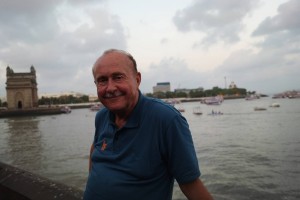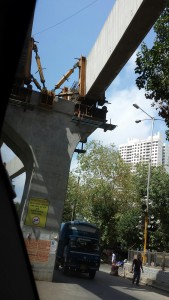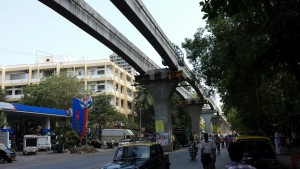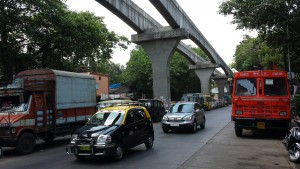In the street facing the Dodha complex – which is the skyscraper I am currently living in – a lot of concrete is being used for building the MonoRail tracks. Over the narrow street, a two-lane concrete line is snaking its way through many very different houses. Eventually, it is supposed to prepare the way for the Mumbai monorail train through the city.
The only other project of this kind is the “Fly Over”, probably the most important higher-level street in Mumbai, part of which also detours onto the ocean, thus connecting the city districts and their skyscrapers. As I already wrote, you can categorize the skyscrapers into three classes: “already finished”, “still under construction” and “not finished, but no longer under construction”. In fact, I am sure you could find quite a few other exciting categories, as well.
Somewhere in Mumbai, the MonoRail is already active, connecting it to a not-yet finished future city. It has almost become a tourist attraction. However, one cannot really call it a tourist attraction in the same league as the magnetic levitation train to Shanghai Airport.
To me, the MonoRail looks like a prestige object of Mombai. In terms of public transportation, I doubt that it will be all that beneficial. But then, a MonoRail is definitely something special and therefore a good means to improve the reputation of Mumbai as a modern city. Besides, the project will also mean that some very rich will become even richer. In India, a few always means a few more. And whenever a huge project will increase private prosperity, then it is definitely justified.
A short time ago, a new government was installed. It is leaning towards right-populist. Instead of dealing with apparent problems, the first thing it did was forbid the consumption of beef, making it punishable most severely. And before the elections, they promised to install air-conditioning in all those many old Metro trains with open doors and windows. Because AC is always something people are in favour of. This intent is probably something totally impossible to put into practice.
In another district, they want to introduce an identity card for every cow. In order to guarantee that the cow has a happy life. Regardless of the fact that India is one of the world’s biggest – if not the biggest – beef exporting nation. However, it seems more like these measures are meant to oppose Muslims, who allegedly are the powers behind the Indian beef industry.
To me, it also seems the women are still treated rather strangely in India. They do not seem to be met at eye-level, there is always the insinuation that they are second-class persons. Sexuality is rather absent from public life, so it seems that the society is a rather prudish one.
And apparently, this causes friction, at least among the male population. In order to avoid escalation, you get separated compartments for women in the often over-crowded metro. Just like there are compartments that may only be used by disabled persons or cancer patients. These are easy to recognize by the symbol for cancer, which is a big circle with a huge crab in the middle and the handicapped symbol we, too, are familiar with.
We, however, being Westerners, mostly go places by car (a white Toyota six-seater) and consequently spend (too) much time on the streets of Mumbai. Somehow or other, there is no alternative. Even if we go only short distances, it takes quite long, because of the traffic jams. The ever-present AC makes it bearable.
Our driver works for a company that is a sub-company of a sub-company of a very big company. They also drive for Western companies. Formerly, these enterprises had their own cars and employed drivers. But that was expensive – although objectively it was very cheap. And then they started saving money and outsourcing.
Now, the combination driver/car is supplied as a full service by huge enterprises, using various providers. Some provide the cars, others the drivers and again others the service. The drivers get less money, the customers are less happy, but the enterprises make a mint. Basically, all services seem to be provided by huge service enterprises.
Foreign companies in India mostly produce things that probably nobody will need any more in the near future, for instance turbines for steam engines. They are for coal-fired power stations. In fact, they mostly do not produce the high-end products. After all, who wants a steam turbine from India for his nuclear power station?
As early as May, the temperature is higher than 40 degrees Celsius, even in the office buildings where the engineers work and where the quality management and similar things take place. You have propellers on the ceilings, but no air conditioning. Because electricity is expensive in India. So it is no surprise that the customers are not always satisfied with how the projects are finished.
The representatives of the state are all friendly and eager to help, which is true for most of the people I met in this country. Allegedly, however, corruption has gigantic dimensions: they say that, without small or larger contributions, nothing goes.
Some families are incredibly rich. The truly rich persons can afford everything; the high import tax on luxury articles does not make the slightest difference. In some underground car parks, you will find a collection of the newest cars with the logos we know quite well, next to some vintage cars that look like they were new. The rich live in fenced communities. In the underground car parks of these areas, you will see entire brigades of people giving their luxury state coaches a new polish after each outing. I have not often seen so much car tin polished to high-gloss and shining chrome as during my few days in India.
More and more people get poorer and poorer. They live on streets that, to my perception, seem even dirtier than they used to be. People live in circumstances that almost defy description. As soon as, two weeks from now, the monsoon will arrive, their homes will regularly be under water.
Live is considerably better in the mostly self-administered slums. But it is not at all easy to get access. Especially if you have absolutely nothing.
At the crossroads and noisy streets, beggars are aplenty. Among them are women and children, elderly persons and handicapped persons. Some women carry a toddler or small child in their wraparound garment while begging. Strangely enough, those children always seem to doze. I never saw any of them cry or sob. Someone told me the babies get medication in order to make them peaceful when the beggaring is under way.
All of Mumbai has a funny odour. You could say it smells. Leaving the plane is not the only moment when you realize that this is so. It seems like the rubbish and dirt increases every year. And Mumbai is a noisy city.
On the 29th floor of the skyscraper, the smell of the city is a little less obvious, but, regardless of the so-called “sound proof window”, this is not true for the noise. On the cars, it often says “horn me” – and that is how it sounds, too.
In between all the common noise, both in the day and at night, you will occasionally get the shrill trumpets of the railway and the loud humming of the helicopters. They drive and fly both by day and night. The noise of the trains comes from below, that of the helicopters from all sides as they fly over or between the skyscrapers. And from above, the noise of regular air traffic will add to the ruckus. All of these contribute to, again and again, robbing me of my sleep in the hot Mumbai.
Some developments I seem to remember from home. Well, not quite as strongly as here. But at home, we also have notices for building contracts concerning public transport where providing the vehicles and the drivers are separate affairs. Especially as a biker, I notice that the plastic waste along our streets constantly gets more. Just like I discover more and more prestigious projects and a tendency towards gigantism by our administration. I also know laws that make no sense and politicians who are incompetent in Germany. And the fact that society drifts apart is not something unknown, either.
It seems like we are learning from the Indian example. But then, as I see it, this sort of “progress” and “growth”, which I am not at all in favour of, seems to happen all over the world: in India and Cuba, China and the USA, Italy and Portugal… And also in Germany.
Luckily, we at home have not yet reached the dimensions I witness in Mumbai. Yet the tendency seems to be the same. The question is: will we manage to turn around? In India, I see no hope that it might still happen.
When I last visited India late in 2013, one Euro still changed into more than 80 Rupies. Currently, I get 70. I ask myself how many Rupies I would still get for my Euro late in 2016? Perhaps only 60? However, since my last visit, life in India has not become any cheaper.
This makes me thoughtful. Perhaps the Indian society is actually the pattern after which the future will form itself –in our country, too?
And yet!
So far, our days in Mumbai were very nice. To be sure, we had a privileged life. I was annoyed to witness the circumstances as I related them. Because noise, smell, sitting in the car during traffic jams and similar things are not at all the world I feel comfortable with.
Yet it was a good time with very happy days. It was nice to share and experience so much with Barbara, my son and his family. And I was lucky enough to see many “Shiny Eyes” in the faces of many simple and certainly in those of poor people on the streets. That is also something to make me happy.
It is probably both the sad and nice thing about being human that we can stand and endure so much. And absurdly enough, we find it easier to be happy when we have less. And when we have to suffer a little. As soon as we are too well off, the shiny eyes disappear in expensive pubs and bars. And near the swimming pool, more often than not, the only shining eyes you sometimes see are among the children.
Consequently, you get happy eyes more often in Mumbai than on the streets of Munich. Basically, this is incredible. But then, I got the same impression during my bike tour through the west of Cuba a few months ago.
RMD
P.S.
I learned the term “Shiny Eyes“ from Nadja. With her work, Nadja wands to contribute towards “more shiny eyes”. As I see it, this is a wonderful idea.






